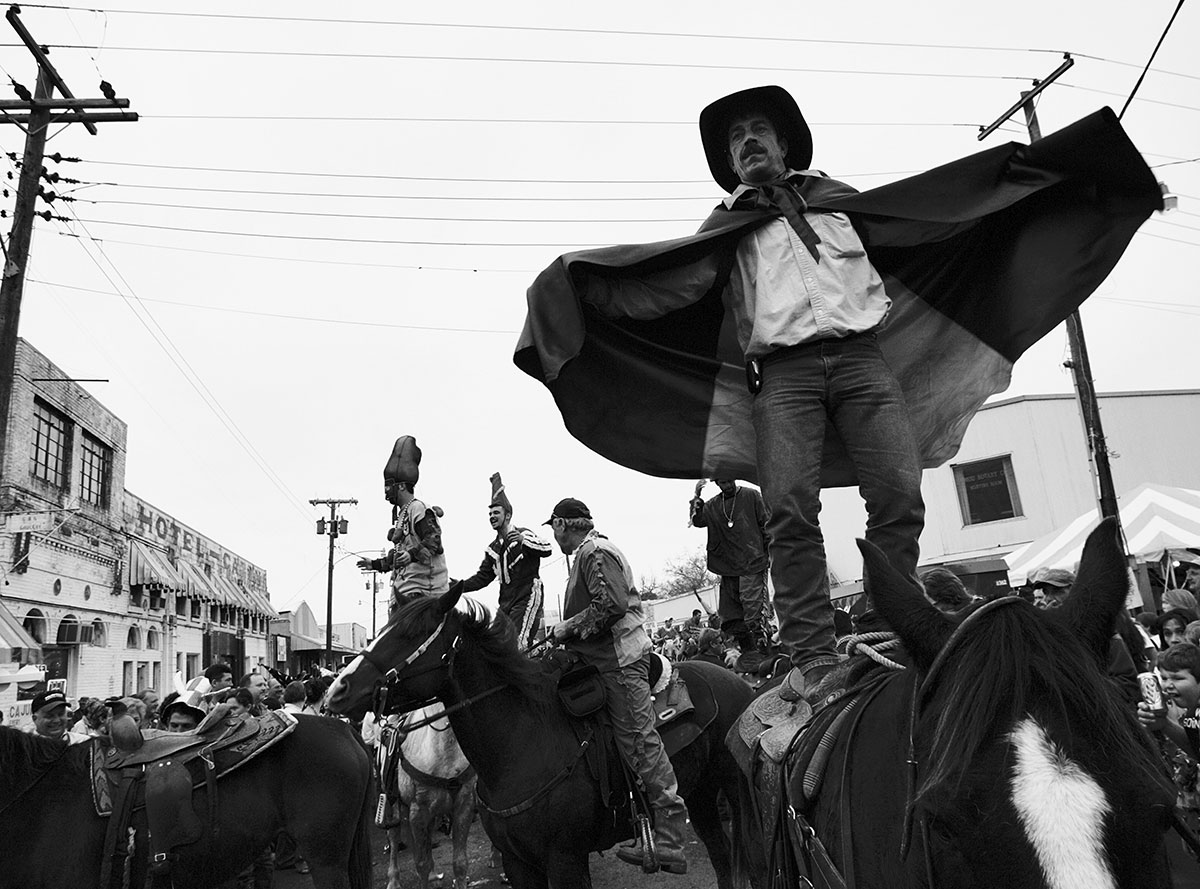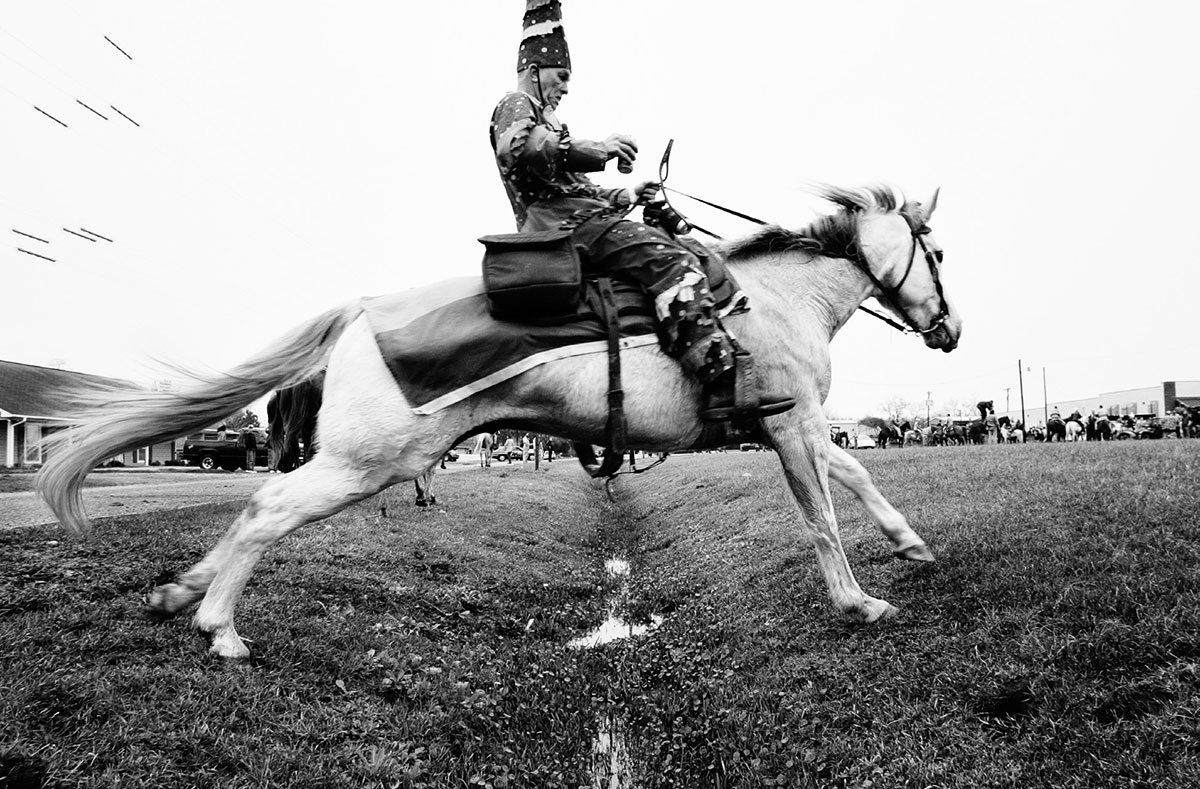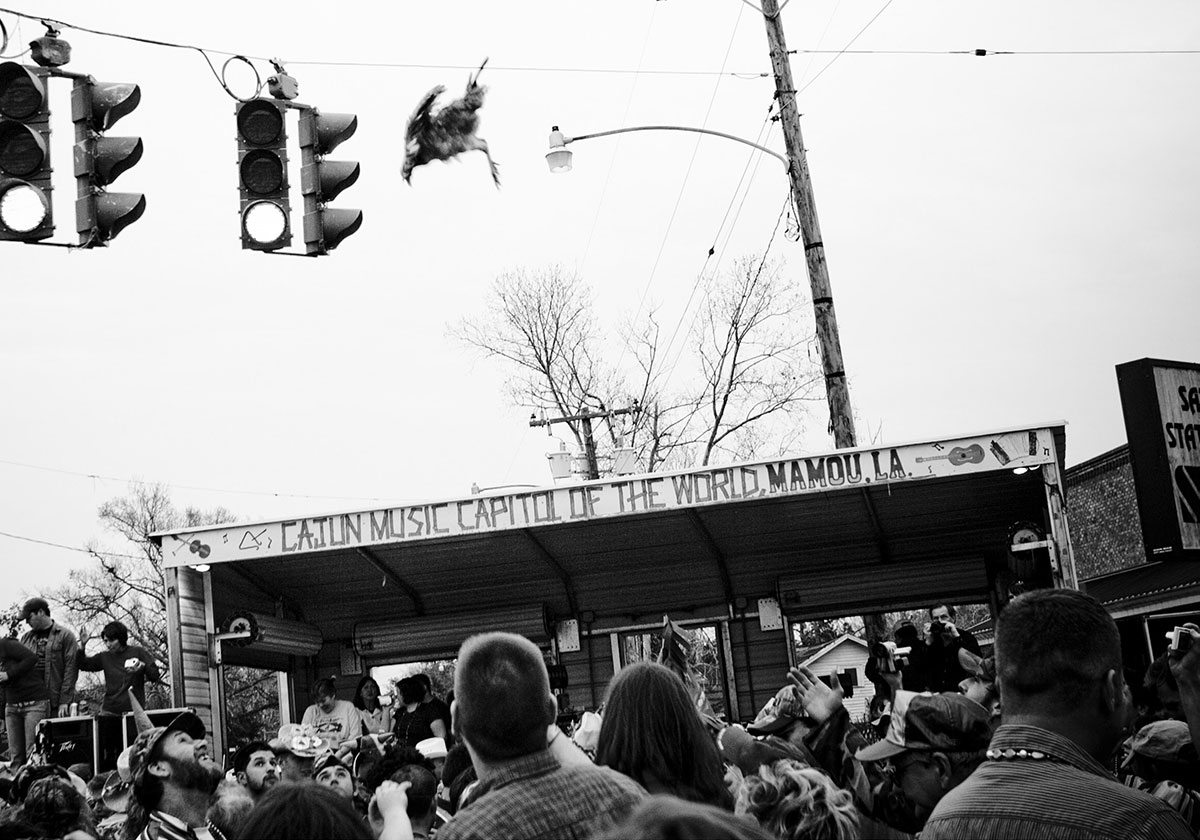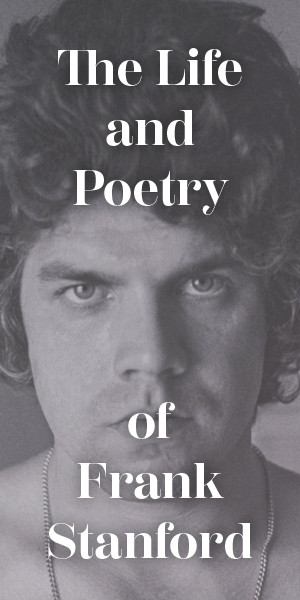
All photographs of Courir de Mardi Gras in Mamou, Louisiana, 2005 and 2007, by Lance Rosenfield. © The artist
The Begging Song of Grand Mamou
How one of the oldest songs in America lives on
By Jordan LaHaye Fontenot
I learned the Mardi Gras song in my grandparents’ home. During family celebrations—Mardi Gras and otherwise—our extended family would settle into the living room, or under the oak tree in the front yard, circled around my uncles Danny and Jay. Throwing their heads back, they’d sing:
Capitaine, capitaine, voyage ton flag.
Allons se mettre dessus le chemin.
Capitaine, capitaine, voyage ton flag,
Allons aller chez l’autre voisin.Les Mardi Gras se rassemblent une fois
par an
Pour demander la charité;
Ça va z’aller’ z’en porte n porte.
Tout a l’entour du moyeu.Captain, captain, wave your flag.
Let’s get on the road.
Captain, captain, wave your flag,
Let’s go to the other neighbor’s place.The Mardi Gras come together once a
year
To ask for charity;
They are going to go from door to door.
All around the hub.
My uncles’ rendition of “La Danse de Mardi Gras,” which they played on acoustic guitars rather than the traditional fiddle or accordion, was an amalgamation of many popular versions recorded throughout the song’s history. It possessed the frantic foot tapping of the Balfa Brothers’ from the 1970s, the vocal dynamism of Steve Riley’s from the ’90s. But they sang all twelve verses, extending the song far past its radio-approved length. This was because they had originally learned the song from its earliest 1950s recording—that of my great-grandmother’s brother, the Cajun musician Elby “Bee” Deshotels.
Against the wild energy of a medieval melody so familiar we felt we must have known it since long before our time, we’d clap our hands, stomp our feet. The rhythm of the song is malleable—as attuned to the human heartbeat as to the gallop of horses. Played fast, especially on the accordion, it lifts an audience into each other’s arms, feet keeping time, so very easily. Played slow, the lyric Donnes-nous autres une tite tres up peu de la graisse / Pour q’on se fait un gombo gras (“Give us a little fat hen so that we can make a fat gumbo”) can practically bring a grown man to tears.
“One of the reasons it is one of the most popular Cajun songs in general is because it is one of the only songs in the repertoire that uses a minor key,” said Louis Michot, lead singer and fiddler for the Grammy-award-winning prog-Cajun band Lost Bayou Ramblers, who had recorded a version of the Grand Mamou Mardi Gras song in 2019. Sitting on the back porch of his Acadian-style boussillage home in Arnaudville, just a few weeks before Mardi Gras, we waxed romantic on the song and its potency within Louisiana French culture. “You feel the end of winter in that song, like the wanting and the needing,” he said. “You’re hungry and you’re drunk…and you’re looking for a feast.”
“We remember,” added Michot’s wife Ashlee, a junior high French teacher and language preservationist. “There’s something we remember about that song. A cultural, collective memory. It’s powerful.”
I was an adult before the Cajun French lyrics meant anything to me, but as a child I remember hearing “La Danse de Mardi Gras” on the radio and being proud that I knew the words. My younger brothers picked them up, too, as did my cousins. Growing up at the end of the millennium in Evangeline Parish, our thoroughly English-speaking tongues learned only scraps of our ancestors’ language. But, we all know the Mardi Gras song.
“I think it serves a huge purpose,” said Ashlee Michot on the song’s role in connecting Louisiana’s new generations to their French heritage. “It’s so small, like a needle, but it’s strong enough. To this day, you see [locals] in Mamou, and you know they don’t speak French anymore, but they sing this song so well. There’s a pride to knowing this song.”
This idiosyncrasy became especially apparent when the Evangeline Parish natives of my generation started to get married. No matter what time of year it was, Steve Riley and the Mamou Playboys’ “La Danse de Mardi Gras” became a crucial part of every local couple’s wedding playlist, right up there with “Sweet Caroline,” “Brown Eyed Girl,” and “The Cupid Shuffle.”
There is an element of ritual to the thing: As soon as you hear the fiddle’s intro, you run to the bar, or the ice chest; you pull out the spare beer you’ve been storing in your back pocket. You’ve got about thirty seconds to balance it sufficiently on top of your head before the lyrics begin, by which point you should proceed with your two-step. Trance-like, you spin, and you stomp, and you circle your friends and your lovers, Coors Light in your hair and the magical tension of the ancient fiddlesong wrenching through your heart as you beg and you beg for a fat chicken, some potatoes, some corn.
“People enter some other realm of existence when we play that song. They just go to another place,” said Riley over the phone in February, just a few days after his first live performance since Mardi Gras 2020, just before the coronavirus pandemic onset. Held at the Acadiana Center for the Arts, the “La Danse de Mardi Gras” showcase featured the Grand Marais, Basile, Tee Mamou, and Ossun Mardi Gras krewes performing their traditional songs—Riley’s iconic version of the Grand Mamou anthem serving as a harmonious thread connecting each performance.
The fifty-two-year-old Cajun music superstar (who, full disclosure, also happens to be my husband’s godfather) recorded his high-energy version of the folksong with his band the Mamou Playboys in 1995, and it continues to hold court as perhaps the best-known and -loved song in the modern repertoire of Cajun music.
The “other realm” Riley speaks of is, of course, the feast of fools to which the song refers: the inside-out, upside-down world of the Courir de Mardi Gras. A ruddier, rowdier folk cousin to the lavish pre-Lenten pageantry of New Orleans Carnival, the Courir de Mardi Gras is practiced in a collective of small towns in the Acadiana region of Southwest Louisiana. The courir (which translates to “run”) refers to the annual reenactment of medieval begging rituals, taking the form of a daylong pilgrimage made by a cast of revelers on horseback—disguised in carefully curated rags, grotesque masks, and conical hats called capuchons, which are meant to parody those of the nobles or the clergy. The courir travels from house to house, begging for ingredients to complete the recipe for a community gumbo to be prepared and shared at the end of the day. When they arrive, landowners occasionally present the group with onions or with rice. But more often, they’ll bestow upon them a live chicken—which Le Capitaine (the leader of the courir) will then toss into the air, eliciting the iconic Cajun chicken chase. Picture ten to fifty grown, intoxicated, exhilarated adults racing across a rice field, rolling in mud, shoving each other out of the way in hopes of being the victorious captor. In exchange for the gifts, the Mardi Gras (used as a plural noun referring to the procession’s riders) offer entertainment to the landowners in the form of song, dance, and mischief of all sorts.
Today, around thirty small towns host a version of a courir, each with its own customs, sets of rules, and evolutions. In Basile, runners frequently pause their revelry to kneel with a palm outstretched, begging for nickels (“Cinq sous, cinq sous!”). Church Point’s Mardi Gras now includes New Orleans-style floats that process behind the riders, throwing beads in a blend of bacchanalia. A key facet of Gheens’s ritual involves (symbolically, and non-violently) whipping children. Faquetaigue has become known by some as the “hipster” courir, famous for its grease pole climbing challenge. In Arnaudville, a brand-new courir emerged in 2019, which reverses the traditional power structure—placing courir leadership in the hands of the women. In Grand Mamou, the day begins with a prayer, recited in French.
Each courir comes with its own musical traditions as well, though a Mardi Gras-tuned ear can easily pick up the common threads—which connect the Grand Marais drinking songs to the Elton begging songs to the call-and-response iterations of the Mardi Gras song sung at Anse Prien Noire’s Creole courir.
The version of the Mardi Gras song we grew up on came out of the rice fields of Evangeline Parish’s Grand Mamou—the rural heart of the Acadian prairie, home to one of the oldest and most staunchly traditional courirs still running: In Mamou, you still have to wear a mask, and you have to ride horseback. And you still have to be a man. This commitment to authenticity arises from Mamou’s prestige as the first town to revive the courir in the 1950s, after Americanization and the effects of World War II had almost rendered the tradition— along with most other facets of French Louisiana culture—extinct. In a remarkable act of cultural preservation, activists Paul Tate and Revon Reed consulted community elders on the celebration of their ancestors and reinstated the tradition as a wildly popular rite of passage in Mamou. Nearby towns followed suit over the course of the next several decades.
Being both lousy on horseback and a woman, I’ve always had to visit the nearby town of Eunice to ride Mardi Gras (via a hay bale trailer “float”). But I’ve been watching the Mamou runners since I was a child. And even in Eunice, it’s the Mamou song that we all sing.
The Mamou version’s popularity can largely be attributed to the widespread fame of Riley’s spirited, melodious rendition—which blares from Acadiana radio stations year-round, with increasing insistence during the pre-Lenten season. Before Riley’s, though, there was the Balfa Brothers’ “La Danse de Mardi Gras.”
“Growing up in Mamou, I feel like the song is just part of my DNA. I couldn’t tell you where I heard it for the first time. But I do know that the Balfa Brothers’ version with the fiddles is the one that stuck with me,” said Riley. The Brothers’ 1974 recording of La Danse (with Swallow Records) is less sophisticated than Riley’s. The chorus—sung in unison—possesses that old quality of the Mamou Cajuns who grew up speaking French first, the fiddles screeching in their dissonance, the upbeat triangle clanging in the background.
The Balfa Brothers, also from Evangeline Parish, are best remembered today for their pivotal role in introducing Cajun music into the mainstream and leading the way to the Cajun Renaissance of the 1960s and ’70s. Many of their songs are still played on local radio stations, considered classics—including “La Danse de Mardi Gras,” which was featured on the soundtracks of Passion Fish (1992), Beasts of the Southern Wild (2012), and even as recently the 2019 thriller Serenity, starring Matthew McConaughey.
“Going to see the Mardi Gras, you’d hear the Balfa Brothers’ version being pumped out of car stereos on the run,” Riley said. “And after we recorded our version, a couple of years later we were on the Mardi Gras run… To hear our version as the one that people were playing…it was just like, ‘wow.’”
Occasionally, especially around Mardi Gras, the radio stations will even play an earlier version recorded by Nathan Abshire and Dewey Balfa (the most famous of the Brothers)—a field recording from 1961 released as “The Mardi Gras Song” on J. D. Miller’s Kajun label, for which the musicians iconically imitated the sounds of hoof clops using coconuts.

All photographs of Courir de Mardi Gras in Mamou, Louisiana, 2005 and 2007, by Lance Rosenfield. © The artist

All photographs of Courir de Mardi Gras in Mamou, Louisiana, 2005 and 2007, by Lance Rosenfield. © The artist
“L a Danse de Mardi Gras” is considered by most to be the oldest song in the Cajun repertoire, though its definitive origins—like many of the traditions surrounding the courir—remain elusive. Most of the communities in which the courir tradition historically took place were largely illiterate and French-speaking until the early twentieth century, but as musicologist Harry Oster and anthropologist Rocky Sexton note in their 2001 article for the American Folklore Society, “Une ’Tite Poule Grasse ou la Fille Aînée: A Comparative Analysis of Cajun and Creole Mardi Gras Songs,” oral history indicates that the courir and its songs were considered tradition by at least the mid-nineteenth century.
Oster and Sexton draw undeniable thematic connections between the South Louisiana Mardi Gras begging songs—such as Grand Mamou’s—and the songs of other “begging” feasts of La Guignolée, France’s Mardi Gras, and La Chandeleur in the Upper Midwest, Quebec, and continental France. Beyond lyrics, Oster (in the article “Country Mardi Gras in Louisiana” published in the 1960 edition of the Louisiana Folklore Miscellany) also noted that the song’s gapped and modal scale suggested ancient French origins. Based on this research, it is plausible that the modern version of “La Danse de Mardi Gras”—preserved so well via modern recording technology—is the consequence of diaspora after diaspora, traveling with the French and the Acadians and their celebrations from France and Canada and the Upper Mississippi River Valley (or just as likely, from France to Canada to the Upper Mississippi River Valley) to Louisiana, gathering bits and pieces and losing others along the way.
“It’s one of the oldest songs in America that has had a reason to survive,” said Michot. Growing up alongside his father’s band Les Frères Michot (whose version of the song was recorded on the album Elevés á Pilette in 1987), Michot—like Riley—can’t remember not knowing “La Danse.”
What Tate and Reed achieved by revitalizing the courir tradition in Acadiana might be compared to that of founding a city, or even a country. This otherworldly, wonderland experience of Mardi Gras—rooted so deeply in place—continues to connect those of us who grew up in rural South Louisiana to our home and to our past. As the folk French Louisianan way of life fades just a little more into the realm of memory with each passing generation, the courir parades onward, as popular and visceral as ever.
“Mardi Gras…I mean, like you’re kind of in heaven, kind of on another planet. Society is turned totally upside down,” said Michot. “And that song…It brings you back to that beautiful time, every time you hear it, any day.”
With the courir, “La Danse de Mardi Gras” might have been lost had it not been for Tate and Reed’s activism, which revealed one community elder who remembered, upon reflection, the song they used to sing during the Mamou courir of days past. Only during my research for this article did I come to realize that every version of the Grand Mamou Mardi Gras song derives from the recitation they acquired from Marcellus Deshotels, my great-great-grandfather— whose ancestors can be traced back to Quebec, and before that to continental France.
Between 1956 and 1959, Oster recorded my Great-Uncle Bee singing it, accompanied by Angelus Manuel on fiddle and Savy Augustine on triangle. The field recording is included in Oster’s record Folksongs of the Louisiana Acadians Recorded in Grand Mamou (1959) and is the first known recording of “La Danse de Mardi Gras.”
On the Thursday before Mardi Gras in 2022, I visited the Center for Louisiana Studies in Lafayette, Louisiana, in order to hear it for myself. In the corner of the library, I held the headphones to my ears and listened to Bee yell out, like a wild man: “All right z’hommes, allons se mettre dessus le chemin et allons courir Mardi Gras. Ehu le capitaine? Capitaine, voyage ton flag.” Whispering, I sang along.
Four days later on Lundi Gras, I sang it again. But this time, as it’s meant to be sung: my body squeezed into a crowd of drunken revelers, spinning under my husband’s finger, Coors Light on my head. The performer? Steve Riley’s twelve-year-old son Burke, squeezing an accordion in a near perfect imitation of his father—belting out the lyrics to a song we’ve all known for centuries, and that the next generation will know, too.






